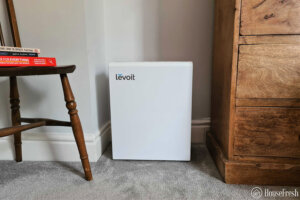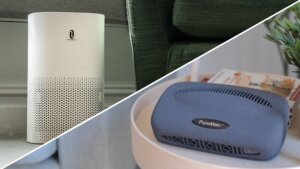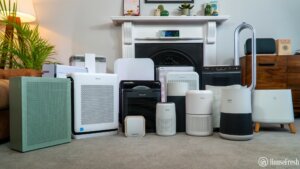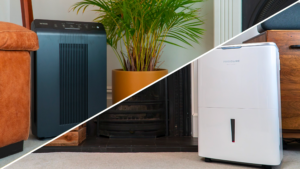When pollution comes to mind, we conjure images of climate change, plastic-filled oceans and smoggy skies. It’s a grim reality; human activities are wreaking havoc on the planet. But we often forget that the hazards and effects of contamination don’t stay outside once we shut our home doors behind us.
Enter Indoor Air Quality (IAQ). Lately, IAQ has gained considerable significance, primarily by the spotlight cast upon it during the COVID-19 pandemic. As we pay more attention to air quality and ventilation within enclosed spaces, we’re beginning to realize the true impact of indoor pollution. Surprisingly, the air inside our homes can be up to five times more polluted than outside air, according to the Environmental Protection Agency (EPA).
The American Lung Association explains that poor indoor air quality can have extreme side effects on human health, ranging from respiratory diseases like asthma and emphysema to the increased risk of cancer and cardiovascular problems. Considering that the average American now spends around 90% of their time indoors, that’s an alarming amount of exposure to potentially contaminated air. This is particularly true when we tightly shut our windows and doors during the colder months.
That’s why understanding the factors behind indoor air pollution is crucial. Knowing the causes allows us to make informed decisions and improve our living environment. In this article, we will explore the most common sources of air pollutants found in everyday homes to help you take action toward creating a healthier indoor environment.
According to the EPA, you should be aware of 13 common causes of indoor air pollution. The CDC categorizes them into three different types:
- Chemical pollutants (such as carbon monoxide, tobacco smoke, volatile organic compounds (VOCs) and radon)
- Biological pollutants (including bacteria, molds, viruses, animal dander and dust mites, among others)
- Toxic materials (such as asbestos and lead).
Let’s now break them down in detail.
Cause of indoor air pollution #1: Asbestos
Asbestos is a naturally occurring mineral fiber known for its resistance to heat and corrosion. Due to these properties, it has been widely used in building construction materials, fireproofing and various commercial products.
However, asbestos is one of the most harmful airborne contaminants, posing significant health risks upon exposure. It becomes dangerous when disturbed or damaged in some way to release particles and fibers into the air, for example, in demolition, maintenance, repair, or remodeling works on or near asbestos. But if the material remains undisturbed and in good condition, the risk of exposure is minimal.
Breathing in high levels of asbestos fibers can lead to severe health conditions such as lung, larynx and ovarian cancer, as well as mesothelioma (cancer affecting the lining of the chest and abdomen) or asbestosis (a lung condition characterized by fibrous tissue scars).
The material in good condition is not likely to release asbestos fibers. But if damaged, or if you are going to make changes in your home that might disturb it, reach out to experts who can safely conduct tests and handle asbestos using the proper procedures.
Due to its hazardous nature, asbestos use is now heavily regulated. The EPA has implemented measures since the late 1980s, successfully banning asbestos in various products such as corrugated paper, roll board, commercial paper, specialty paper and flooring felt. Additionally, the development of new asbestos applications is prohibited in the U.S.
However, due to its past use, asbestos may still be found in many homes and buildings.
| Sources of Asbestos at Home: |
| 🏠 Roofing and siding shingles 🏗️ Ceilings, floors and wall insulations 🖌️ Textured paint and patching compounds, used on wall and ceiling joints (this use was banned in 1977) 🔥 Heat-resistant fabrics and fireproofing materials 🚗 Brake pads (cars, elevators) 🧱 Some vinyl floor tiles, vinyl sheet flooring and adhesives 🚿 Hot water and steam pipes coated with asbestos 🧴 Other mineral products, such as talc and vermiculite, can be contaminated with asbestos. |
Airborne asbestos fibers are tiny solid particles ranging from 0.7 to 90 microns in size. Because they’re small and lightweight, they can stay in the air for a long time.
HEPA (high-efficiency particulate air) filters are designed to effectively capture all kinds of small airborne particles, including asbestos.
➡ Our top pick for asbestos: Levoit Core 400S.
Cause of indoor air pollution #2: Biological pollutants
Biological pollutants are contaminants derived from living organisms. As such, they are often found in areas that provide food and moisture for them to thrive.
| Common Biological Contaminants at Home: |
| 🐝 Pollen from trees and plants, insects, or insect parts. 🍄 Mold and fungi caused by excess moisture, such as leaks, stagnant water in appliances, poor air circulation and poor insulation 🦠 Microbes (bacteria, viruses) transmitted by people, animals, soil and sometimes food 🐕 Pets’ hair, saliva and dander 🐀 Cockroaches and rodents’ droppings and saliva 🔬 Dust mites, microscopic bugs that live in carpets, mattresses and upholstered furniture |
Many of these are invisible to the naked eye and small enough to be inhaled. While it’s impossible to eliminate them, it is best to keep them to a minimum and reduce the health risks they pose.
Biological contaminants can trigger allergic reactions (hypersensitivity, allergic rhinitis, pneumonitis and various types of asthma), transmit airborne infectious diseases (like measles, influenza and chickenpox) and release harmful toxins into the air.
Common symptoms include:
- Sneezing and coughing
- Watery eyes
- Shortness of breath
- Dizziness and lethargy
- Fever
- Digestive problems
Exposure to biological pollutants at home can be reduced with an air purifier. HEPA filters can effectively remove up to 20% of these pollutants, helping to create a healthier and cleaner indoor environment.
➡ Our top pick for biological pollutants: Levoit Core 600S.
Cause of indoor air pollution #3: Carbon monoxide (CO)
Carbon monoxide is a toxic gas that is colorless, odorless and highly dangerous. The incomplete combustion of carbon-containing materials like natural gas, gasoline, kerosene, oil, propane, coal, or wood produces it. Any home fuel-burning appliance is a potential CO source if not correctly installed and maintained.
| Sources of Carbon Monoxide at Home: |
| 🏮 Unvented kerosene and gas space heaters 🔥 Leaking chimneys and furnaces 💨 Gas stoves 🛢️ Generators and other gasoline-powered equipment ♨️Wood stoves and charcoal grills 🔥 Back-drafting from furnaces, gas water heaters, wood stoves and fireplaces |
Tobacco smoke and vehicle exhaust from attached garages, nearby roads, or parking areas can also contribute to CO levels indoors. Due to its undetectable nature, people may not be aware of CO exposure. Therefore, recognizing the symptoms is crucial to reduce the risk of poisoning.
Carbon Monoxide poisoning symptoms can resemble the flu. It will likely be CO poisoning if the symptoms diminish or disappear once you leave your home, as they get worse with exposure.
Low to moderate exposure will lead to the following symptoms:
- Fatigue
- Shortness of breath
- Headaches
- Nausea and dizziness
Higher levels of CO exposure can lead to more severe symptoms:
- Mental confusion
- Vomiting
- Loss of muscular coordination
- Loss of consciousness
Carbon monoxide detectors and ensuring proper fuel-burning appliance installation and maintenance are crucial to reducing CO poisoning risks. Air purifiers with activated carbon filters are an excellent reinforcement as they can remove carbon monoxide from the air.
➡ Our top pick for carbon monoxide: IQAir Healthpro Plus.
Cause of indoor air pollution #4: Cookstoves and household energy
According to the World Health Organization, over 40% of the world’s population relies on burning coal and biomass fuels for cooking, lighting and heating their homes.
These fuels, including wood, charcoal, kerosene, dung and crop residues, release harmful byproducts such as carbon monoxide, nitrous oxide and particulate matter into the air. Poorly ventilated stoves contribute to indoor air pollution, affecting approximately half a million people in the United States alone, as reported by the EPA.
Exposure to these fuels can lead to inflammation of the airways and lungs, compromised immune response and decreased oxygen-carrying capacity in the blood.
As a result, household smoke is a significant risk factor for various diseases, including:
- Childhood pneumonia
- Chronic obstructive pulmonary disorder (COPD)
- Acute respiratory infections
- Heart disease
- Stroke
- Lung cancer
According to the EPA, using non-renewable fuels for cooking also contributes to greenhouse gas emissions. It accounts for approximately 2% of global CO2 emissions, equivalent to aviation emissions. By using improved stoves, these emissions can be reduced by 50-80%, improving indoor air quality and environmental sustainability.
HEPA filters will help reduce particles produced from solid fuels smoke, while activated carbon filters will help with carbon dioxide and other gaseous pollutants.
➡ Our top pick for air pollution from cookstoves: Smart Air Blast Mini with activated carbon filter.
Cause of indoor air pollution #5: Formaldehyde (CH₂O)
Formaldehyde is a common, strong-smelling chemical in our environment. It exists as a colorless, flammable gas at room temperature. It can be produced artificially but is also a natural result of normal metabolic processes in living organisms, including humans and food.
As volatile as it is, formaldehyde quickly evaporates and is released into the air from various indoor and outdoor sources.
| Sources of Formaldehyde at Home: |
| 🏗️ Building materials and insulation 🧪 Household products such as glues, permanent press fabrics, paints and coatings, lacquers and paper products 💅 Preservatives used in some medicines, cosmetics and other consumer products such as dishwashing liquids and fabric softeners 🌱 Fertilizers and pesticides 💨 Emissions from un-vented, fuel-burning appliances, like gas stoves or kerosene space heaters 🚬 Cigarette smoke 🚗 Automobile emissions |
In 2011, the U.S. Department of Health and Human Services classified formaldehyde as a known human carcinogen. However, the risk of developing cancer is primarily associated with long-term and high-level exposure, predominantly in occupational settings producing or working with chemical byproducts.
Most people don’t experience health issues from the small amounts of formaldehyde in their homes.
As formaldehyde levels increase, it can produce the following symptoms:
- Watery eyes
- Burning sensations in the eyes, nose and throat
- Coughing and wheezing
- Nausea
- Skin irritation
Sensitivity to formaldehyde also varies, so while some people may experience some of these symptoms, the same level of exposure can have no reaction whatsoever to others.
Air purifiers fitted with activated carbon can trap odors and gasses, hence are highly efficient for removing formaldehyde.
➡ Our top pick for formaldehyde: Austin HealthMate.
Cause of indoor air pollution #6: Lead (Pb)
Lead is a naturally occurring metal that is abundantly found throughout the Earth. It possesses various properties such as density, ductility (moldability) and resistance to weather conditions, making it useful for many purposes.
However, lead and lead compounds are highly toxic and pose a significant hazard to those exposed. Whether ingested or inhaled, lead is readily absorbed into the body and distributed throughout its systems. No blood lead level is safe.
Lead has been used for many centuries due to its versatility despite its toxicity. Even ancient Romans used it for plumbing, dishes, cosmetics, coins and many other applications. In modern times, lead was added to paint and gasoline to improve performance. It was in the 1970s that the EPA began restricting those uses of lead. However, due to its durability, it can still be found in the environment.
| Sources of Lead Contamination at Home: |
| 🎨 Lead-based paint, which was not banned until 1978 and can still be present in older homes and buildings 🖌️ Contaminated soil from old lead-based paint, past use of leaded gasoline in cars, or industrial activities such as metal smelting and battery manufacturing 💧 Contaminated drinking water, where lead can leach from pipes, faucets and solder, commonly found in the plumbing of older buildings 🛍️ Commercial products such as old toys, furniture, jewelry, cosmetics and food or liquid containers 🎣 Materials used in hobbies such as hunting, fishing, stained glass, stock car racing and pottery making |
Lead can negatively impact almost every organ and system in the body. Children are particularly vulnerable to its effects, and even low levels of lead in their blood can have long-lasting impacts on their development and behavior.
Adults can also experience adverse effects from lead exposure, including:
- Cardiovascular effects, such as increased blood pressure and hypertension
- Decreased kidney function
- Fertility problems
- Degenerative disorders of the central nervous system
HEPA filters can capture lead particles in the air, often around 15.1 microns.
➡ Our top pick for lead: IQAir HealthPro Plus.
Cause of indoor air pollution #7: Nitrogen dioxide (NO2)
Nitrogen dioxide, also known as NO2, is a harmful gaseous air pollutant and belongs to a group of gases called nitrogen oxides (NOx). Nitrogen dioxide is highly corrosive and contributes to ozone formation. The primary source of NO2 is fossil fuel combustion, predominantly from cars, trucks, buses and power plants.
NO2 can also be produced indoors when burning fossil fuels (wood or natural gas).
| Sources of Nitrogen Dioxide at Home: |
| 🌫️ Unvented combustion appliances such as gas stoves ⚠️ Vented appliances with defective installations 🥽 Welding activities 🚬 Tobacco smoke 🏮 Kerosene heaters |
In homes without combustion appliances, the average level of NO2 is about half of what can be found outside. However, homes with gas stoves, kerosene heaters, or unvented gas space heaters often surpass NO2 outdoor levels.
Exposure to NO2 can harm the respiratory system, as it irritates the mucosa of the eyes, nose, throat and respiratory tract. Even short-term exposure can worsen respiratory conditions, especially asthma and trigger coughing, wheezing and difficulty breathing. Prolonged exposure to elevated concentrations of NO2 may reduce lung function and increase susceptibility to respiratory infections.
An air purifier with HEPA and carbon can decrease indoor NO2 concentrations.
➡ Our top pick for nitrogen dioxide: Alen BreatheSmart 75i.
Cause of indoor air pollution #8: Pesticides
Pesticides are chemicals used to kill or control pests. While they are inherently toxic, the EPA reported that 75% of U.S. households used pesticides indoors in the past year and that 80% of pesticide exposure happens inside homes.
| Sources of Pesticide Chemicals at Home: |
| 🧴 Insecticides to control insects 🐜 Termiticides to deal with termites 🐁 Rodenticides for rodents 🍄 Fungicides to tackle fungi 🦠 Disinfectants to eliminate microbes |
While the specific health effects of each pesticide vary depending on its chemical composition, most of these products can irritate the eyes, nose and throat.
Prolonged exposure can have more severe consequences, including:
- Damage to the central nervous system, kidneys and liver
- Increased risk of developing cancer
Carbon filters will help to remove the gasses produced by pesticides from the air.
➡ Our top pick for pesticides: Blueair Blue Pure 211+.
Cause of indoor air pollution #9: Radon (Rn)
Radon is a naturally-occurring radioactive gas produced by the decay of uranium found in rocks and soils. It is invisible, odorless and colorless, virtually undetected without proper testing. While outdoor radon levels are generally low and pose minimal risk, it becomes a health hazard when it infiltrates indoor environments.
Radon gas breaks down into tiny radioactive elements, called radon progeny, that can be inhaled. Prolonged exposure to these increases the risk of lung cancer. According to the EPA, radon is the second leading cause of lung cancer in the United States.
This harmful gas can enter buildings through cracks and openings in the foundation and get trapped inside. It can also permeate water, particularly in regions rich in uranium deposits, contaminating groundwater sources that feed wells and water pumps. Everyday uses of contaminated water, using the kitchen sprayer, showering, and doing laundry, will release the radon into the air.
Since 1993, the EPA regularly updates a Map of Radon Zones. It uses data on indoor radon measurements, geology, radioactivity, soil and foundation types. However, radon levels can vary even within neighborhoods. Testing your home is the only way of knowing if radon levels are high.
An air purifier with activated carbon can help to remove radon from the air. The activated carbon absorbs odors and gasses like radon. Home radon detectors are a great way to monitor radon levels indoors and take action when needed.
➡ Our top pick for radon: Alen BreatheSmart 75i (with Fresh Filter).
Cause of indoor air pollution #10: Indoor particulate matter
Particulate matter, also known as PM or particle pollution, is a complex mixture of solid and liquid particles suspended in the air. PM can be made up of hundreds of different chemicals, metals and organic compounds.
Particles are categorized based on their size. Larger ones are called PM10 and can be inhaled. Finer particles, on the other hand, are called PM2.5 and pose higher health risks as they can get deeper into the lungs and bloodstream.
While the health effects of outdoor PM are well-established, and guidelines exist to regulate outdoor air quality, particulate matter present indoors can potentially exceed outdoor levels.
| Sources of Indoor Particulate Matter Chemicals at Home: |
| 🏚️ Outdoors, airborne particles enter through windows and doors, small openings and cracks in walls and foundations. 🍳 Cooking 🧹 Cleaning products with harmful chemicals 🔥 Combustion activities, such as burning candles or incense, smoking fireplaces and use of fuel-burning appliances in unvented spaces 🧬 Biological contaminants from animals, pests, plants and mold 🖨️ Printers and copiers can generate them directly |
Particle pollution can affect anyone. Still, people with heart or lung diseases (such as asthma), seniors and children are more susceptible to it.
Exposure to PM can lead to various symptoms, such as:
- Eye, nose and throat irritation
- Lung and throat irritation,
- Trouble breathing
- Lung cancer
- Aggravated coronary and respiratory disease
Good ventilation, air purifiers and minimizing indoor particle sources can help maintain healthier indoor air quality. HEPA filters are especially good at removing indoor PM2.5.
➡ Our top pick for particulate matter: Smart Air S (ideally with an Activated Carbon filter)
Cause of indoor air pollution #11: Secondhand smoke / environmental tobacco smoke
Secondhand smoke, or environmental tobacco smoke (ETS), is a significant source of indoor air pollution. It is produced by the smoke from burning cigarettes, or other smoked tobacco products (called sidestream smoke) and the smoke exhaled by a smoker (mainstream smoke).
The chemicals released while smoking can linger indoors for a long time, settling on walls, floors, clothing, bedding, carpets and other surfaces. Over time, they can react with those surfaces and create other pollutants, like MP2.5.
Secondhand smoke is equally as harmful as smoking itself. There is no safe level of exposure, and even EST minimal levels can have negative effects.
Secondhand smoke can have the following adverse effects on your health:
- Trigger asthma
- Irritate the eyes, nose and throat
- Cause respiratory illnesses and lung cancer
- Poses risks to the heart and blood vessels, increasing the likelihood of heart disease by about 25 to 30% and the risk of stroke by 20 to 30%
Air purifiers with HEPA and activated carbon filters can help trap PM2.5 caused by smoking and remove the smoke from the air.
➡ Our top pick for tobacco smoke: Levoit Core 600S.
Cause of indoor air pollution #12: Volatile organic compounds (VOCs)
Volatile Organic Compounds (VOCs) are a large group of chemicals commonly found in household products. Mostly human-made, VOCs can vaporize into the air and become gases at average room temperature. While some are harmful, others react with other gases and form air pollutants. VOCs can be found in the air indoors and outdoors.
| Sources of Volatile Organic Compounds at Home: |
| 🏠 Building materials, such as paint, varnishes and finishes, adhesives, flooring, carpet, pressed wood products 🧽 Cleaners and disinfectants 🌱 Pesticides 💐 Air fresheners 💅 Cosmetics and deodorants 👚 Dry-cleaned clothing 🚬 Tobacco smoke 🚜 Fossil fuel-burning appliances 🎨 Arts and crafts products, such as glues and permanent markers ⛽ Gasoline and diesel emissions 🏭 Industrial emissions |
The potential health effects of VOCs depend on the concentration of these compounds in the air and the duration and frequency of exposure. As VOCs encompass a wide range of chemicals, the health effects can vary depending on the specific toxicity of each compound. H
Short but acute exposure to VOCs can lead to:
- Eye, nose and throat irritation
- Headaches
- Nausea
- Dizziness
- Exacerbation of asthma symptoms
Chronic exposure to VOCs can have more severe consequences:
- Damage to the liver
- Damage to the kidneys
- Damage to the central nervous system
- Cancer
Air purifiers with an activated carbon filter are very good at removing odors, VOCs and gasses from the air in your home. This is due to their absorption qualities.
➡ Our top pick for VOCs: IQAir HealthPro Plus.
Cause of indoor air pollution #13: Wood smoke
Smoke from burning wood and other organic matter produces a complex mixture of toxic gases and particulate matter (PM2.5). Gases released by burning wood include formaldehyde, carbon monoxide, nitrogen oxides and VOCs.
Residential wood smoke is responsible for poor indoor air quality in many areas across the United States. The primary sources include wood and pellet stoves and heaters, hydronic heaters and other appliances, often used 24 hours a day in many homes.
PM2.5 and the toxic gases from wood burning can cause:
- Bronchitis
- Pneumonia
- Asthma
- Aggravated chronic heart disease
- Aggravated lung disease
- Premature deaths in people with chronic respiratory conditions
The EPA Burn Wise initiative offers a Wood Stove Database with EPA-certified wood heaters. All products undergo certification testing at an EPA-accredited laboratory to verify that they meet the required emission standards.
Air purifiers with HEPA and activated carbon filters can help trap PM2.5 and gases caused by wood smoke.
➡ Our top pick for wood smoke: Smart Air Blast Mini (with the optional activated carbon filter)
Final thoughts
Yes, it’s true. Your home may be harboring up to 13 sneaky pollutants, and chances are you’re exposed to more than you realize. But while these pollutants are serious, and it is understandable to feel overwhelmed, don’t panic — take action instead.
Simple steps like ensuring regular ventilation, being mindful of everyday products’ chemical composition and opting for safer cleaning alternatives to keep your home clean can improve indoor air quality. Adding HEPA air purifiers with activated carbon filters to your spaces will provide an extra shield against these pollutants.
Remember, an air purifier is just one piece of the puzzle, so diversify your defense. Stay informed, be proactive and seize control of your indoor environment for a healthier and cleaner living space.
SOURCES
- Agency for Toxic Substances and Disease Registry (2023). Lead Toxicity. atsdr.cdc.gov
- American Lung Association. (2023). Clear Air At Home. lung.org
- American Lung Association. (2022). Volatile Organic Compounds. lung.org
- Asbestos123 (2023). Minimize Asbestos Exposure In Your House With HEPA Air Purifiers. asbestos123.com
- Centers for Disease Control and Prevention and U.S. Department of Housing and Urban Development (2009). Healthy Housing Reference Manual. cdc.gov
- Centers for Disease Control and Prevention and U.S. Department of Housing and Urban Development (2023). Carbon Monoxide Poisoning. cdc.gov
- Centers for Disease Control and Prevention and U.S. Department of Housing and Urban Development (2023). Particle Pollution. cdc.gov
- Esquire, J. L. (2023). Asbestos Ban in the U.S. asbestos.com
- Kumar, P. et al. (2021). Biological contaminants in the indoor air environment and their impacts on human health. ncbi.nlm.nih.gov
- Mannan, M. and Al-Ghamdi, S. G (2021). Indoor Air Quality in Buildings: A Comprehensive Review on the Factors Influencing Air Pollution in Residential and Commercial Structure. ncbi.nlm.nih.gov
- National Cancer Institute. (2022). Asbestos. cancer.gov
- National Cancer Institute. (2018) Secondhand Smoke and Cancer. cancer.gov
- U.S. Consumer Product Safety Commission. (2023). Asbestos In The Home. cpsc.gov
- U.S. Consumer Product Safety Commission. (2016). An Update on Formaldehyde. cpsc.gov
- U.S. Consumer Product Safety Commission. (2023). Carbon Monoxide Fact Sheet. cpsc.gov
- U.S. Department of Health and Human Services. (2021). Report on Carcinogens, Fifteenth Edition. ntp.niehs.nih.gov
- United States Environmental Protection Agency. Indoor Pollutants and Sources. epa.gov
- World Health Organization (2022). Household Air Pollution. who.int







